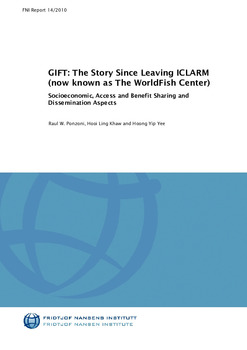GIFT: the story since leaving ICLARM (now known as the WorldFish Center): socioeconomic, access and benefit sharing and dissemination aspects
Abstract
The aim of the overall project of which this report is part is to identify possible solutions for regulating access to aquatic genetic resources and legal protection of the results of research and development in aquaculture using such resources. The case study of the collaborative program on Genetic Improvement of Farmed Tilapias (GIFT) serves as a basis for comparison with two other case studies from Norway on salmon and cod. This study aims to address the following questions: How has the legal regime for GIFT material developed since leaving WorldFish? How has this affected the use and dissemination of GIFT material by the aquaculture sector (private and public sectors)? How has the transfer from WorldFish affected access and benefit sharing of GIFT material? And what are the effects on further developments and innovation of this breeding material? The report concludes that there is no doubt that the GIFT project has had an impact worldwide. Both the technology and the genetically improved fish have been widely distributed and are now known. Whereas we believe that it is fair to say that in many instances the improved fish have reached and benefitted the poor, it is also an area where gross mistakes were made. Such mistakes separated events from a path that could have benefitted the poor much more. The first miscalculation was to assume that GIFT Foundation International Inc. (GFII) was going to rapidly become financially self-reliant and that it did not require further support. This mistake led to another even greater error of judgement, the alliance between GFII and GenoMar, whereby the latter profit-oriented company obtained the right to breed and market GIFT. This decision brought about a change of focus of GFII from breeding and dissemination of GIFT fish to poor and small scale farmers to meeting the business objectives of GenoMar instead

